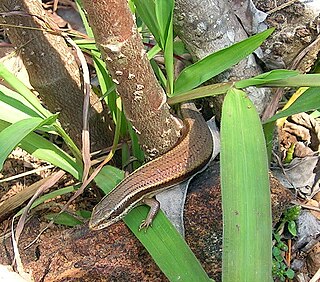
Cryptoblepharus is a genus of skinks, lizards in the family Scincidae. The genus contains at least 53 species.

Cryptoblepharus litoralis, the coastal snake-eyed skink or supralittoral shinning-skink, is a small skink found in North Queensland, Australia and New Guinea.

The yellow-capped pygmy parrot is a species of parrot in the family Psittacidae mainly found throughout western New Guinea. Its natural habitats are subtropical or tropical moist lowland forest, subtropical or tropical mangrove forests, and subtropical or tropical moist montane forest. Like many parrots, this pygmy parrot is affectionate to its mate. It is currently unknown if they remain monogamous for life like many bigger parrots because of their isolated location, which is difficult to reach.
The Kei goby is a species of goby native to marine and brackish waters along the coasts of Mozambique, South Africa, Madagascar and the Seychelles. This species can reach a length of 7 centimetres (2.8 in) TL.

Lygosominae is the largest subfamily of skinks in the family Scincidae. The subfamily can be divided into a number of genus groups. If the rarely used taxonomic rank of infrafamily is employed, the genus groups would be designated as such, but such a move would require a formal description according to the ICZN standards.

Cryptoblepharus virgatus, also commonly known as striped snake-eyed skink, cream-striped shinning-skink, wall skink, fence skink or snake-eyed skink is a skink commonly found in southern and eastern Australia. It is an active little lizard, and if threatened will often play dead to confuse the attacker.

Cryptoblepharus australis, commonly called the inland snake-eyed skink, is a species of skink in the genus Cryptoblepharus.
Richard Sternfeld was a German-Jewish herpetologist, who was responsible for describing over forty species of amphibians and reptiles, particularly from Germany's African and Pacific colonies.
Paraperipatus keiensis is a species of velvet worm in the Peripatopsidae family. Females of this species have 24 or 25 pairs of legs; males have 22 or 23 leg pairs. The type locality is in Kai Besar in Indonesia.
Cryptoblepharus yulensis is a species of skink, a lizard in the family Scincidae. The species is endemic to Papua New Guinea.
Cryptoblepharus cygnatus, also known commonly as Swanson's snake-eyed skink, is a species of lizard in the family Scincidae. The species is endemic to the Northern Territory in Australia.
Cryptoblepharus exochus, also known commonly as the noble snake-eyed skink, is a species of lizard in the family Scincidae. The species is endemic to the Northern Territory in Australia.

Cryptoblepharus gloriosus, the Glorioso snake-eyed skink, is a species of lizard in the family Scincidae. It is endemic to the Comoros Islands, and can be found on Mayotte, Mohéli, and the Glorioso Islands.

Cryptoblepharus juno, commonly known as Juno's snake-eyed skink, is a species of lizard in the family Scincidae. The species is endemic to the Northern Territory, Australia.

Cryptoblepharus nigropunctatus, known as the Ogasawara snake-eyed skink, is a species of lizard in the family Scincidae. It is endemic to the Bonin Islands of Japan.

Cryptoblepharus novaeguineae, the New Guinea snake-eyed skink, is a species of lizard in the family Scincidae. It is endemic to Indonesia and Papua New Guinea.
Cryptoblepharus ochrus, also known commonly as the pale snake-eyed skink, is a species of lizard in the family Scincidae. The species is endemic to the Australian state of South Australia.

Cryptoblepharus plagiocephalus, Péron's snake-eyed skink or the callose-palmed shinning-skink, is a species of lizard in the family Scincidae. It is endemic to Australia.
Cryptoblepharus wulbu, also known commonly as the spangled snake-eyed skink, is a species of lizard in the family Scincidae. The species is endemic to the Northern Territory in Australia.
Cryptoblepharus xenikos is a species of lizard in the family Scincidae. The species is endemic to Papua New Guinea.











